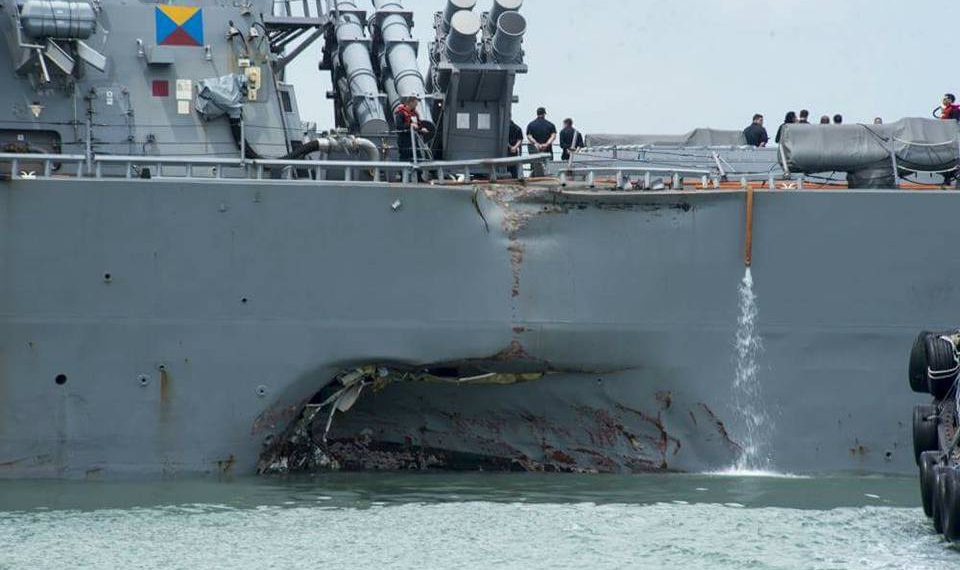US Navy in troubled waters : Why do the 7th fleet ships keep on crashing into things ?

This year alone has seen the USS Antietam run aground in Tokyo Bay; The USS Lake Champlain colliding with a South Korean fishing vessel; The USS John McCain crashing into an oil tanker near Singapore and the USS Fitzgerald smashing into a cargo ship off the coast of Japan.

So what are the causes behind those incidents ?
Some experts are quick to point out the US Navy is over-extended with too many commitments around the globe and not enough ships to fulfill those missions. It is a well known fact the Navy is clamouring for a 355 combat ships fleet. At present time, it “only” possess 276 of those ships of which around 100 are at sea at any given time.

On average across the board, US Navy ships spend 40% of their time in deployment with the remaining 60% shared between ship maintenance and crew training.
Not so in the Pacific fleet, though: Ships belonging to the 7th fleet spend on average 67% of their time in deployment leaving only 33% for maintenance and no time at all left for training. Said training is therefore done “on the go” during deployments.
As a result, it has been found that as many as 17% of the 7th Fleet crew members are operating with expired certifications.
So while some experts talk about crew complacency and a casual attitude toward navigation which could be partly responsible for those incidents, it is clear that the biggest culprits are the lack of training and the high crew turnover on board the fleet’s ships (meaning each navy ship has a high ratio of green recruits). After all, those incidents occurred during routine transit time when only the basics in navigation and watch keeping are required. And the situation gets worse as each ship involved in an incident is withdrawn from the fleet for repairs leaving a heavier burden on the remaining vessels and crews.

So… what can be done ? Well, the US navy has two choices, really:
– It could decide that times have changed and that the navy cannot afford to be anywhere, anytime all of the time anymore and cut its commitments and operational tempo. Subsequently, it could focus on a smaller navy, better equipped and trained.
After all, Great Britain, France and to a lesser extend the Netherlands, all have a smaller navy and still manage to maintain an intermittent presence on every seas of the globe.
Alternatively,
– It could decide that expansion is key and build new ships to try and reach the magic “355” number.

As it is very unlikely that the US navy will accept to play a smaller role in the global arena, it seems the only way is up. Not that it’s going to be easy, mind you… Building another 80 odd ships could take time. Lots of time. In fact, as those ships would start entering service, the US Navy would be in the process of retiring other older ships, offsetting the balance and the total amount of ships available in active service. The strain on the US budget would be enormous, also.

One temporary solution would be to reactivate some of the older Oliver Hazard Perry class ships. The last one was retired in 2015 and they are slowly being transferred to foreign navies or sank as reef or used as live targets. There are approximately 30 ships of this class in reserve at present time and while they are indeed worn out and unfit to stand in the first line of a modern conflict with a peer enemy, it could be argued that if they are good enough to serve in foreign navies, they are good enough to serve in the US Navy for missions of lesser importance. Think fly the flag, visits to friendly nations and other diplomatic activities, anti-piracy patrols and routine patrols in international waters/navigation channels. This would free the other better performing ships for other operations, think South China Sea and North Korea. While it would only be a temporary solution while the navy ponders it’s long term future/role/ambitions, it could in the short term relieve the strain on the ships and crew members currently serving.

After all, those accidents not only cost millions of dollars, they are also costing lives.








